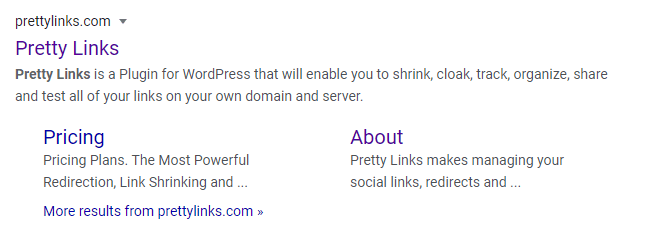Así se domina la meta descripción para mejorar el SEO

Contenido
We need to get something about meta descriptions out of the way first and foremost: they do not matter to Google’s ranking system.
If there’s one thing you can count on from Google, it’s foggy and hidden information about what’s best for search engines. Meta descriptions are not exempt from the murkiness.
De hecho, incluso la longitud permitida de las descripciones de búsqueda ha subido y bajado a lo largo de los años (saltando a 320 caracteres en diciembre de 2017, solo para volver a bajar a 160 caracteres en mayo de 2018). Mantenerse al día con estos números cambiantes es una batalla frustrante pero necesaria en el camino hacia una mayor tasa de clics (CTR).
You might wonder what the point of the rest of this post is, then. If Google doesn’t care about meta descriptions, why should you bother expertly crafting them? If your SEO efforts are unrewarded, why not skip them and head to the next optimization tactic?
Meta descriptions may not be part of Google’s ranking system, but they ARE a boon to your SEO strategy. They help improve the chance that a user will click through to your site, and at times they are la primera y única oportunidad que tengas.
In this blog post, we’re going to tell you why you should write meta descriptions, how you should write them, and what to remember to get the best CTR. Let’s get started!
¿Qué es una meta descripción?

Let’s start by defining a meta description. According to Moz:
La meta descripción es un atributo HTML que proporciona un breve resumen de una página web. Los motores de búsqueda como Google suelen mostrar la meta descripción en los resultados de búsqueda, lo que puede influir en el porcentaje de clics.
You’ve seen a meta description even if you don’t know what it is off the top of your head. It’s the excerpt that you find under the meta title in a search result.
It’s easy to see why these little descriptors are so important. They can be the only information a user has to decide whether they’ll click the link to your site or move on to someone else’s. In short, meta descriptions let the user know whether or not your page can solve their problem.
The interesting thing is that Google doesn’t always show your meta description. Research by Moz shows that custom meta descriptions are shown by Google only 51.3% of the time. This is due to several factors, including relevance, and is heavily dependent on the keywords used in the user’s search (more on that later).
¿Por qué es importante una meta descripción?

¿Debe escribir una meta descripción? Por supuesto. El SEO consiste en combinar tácticas para impulsar su sitio en los motores de búsqueda, y las meta descripciones son una táctica demasiado fácil como para saltársela.
Consider these two-sentence-wonders your first-contact click-through bait. After you’ve input your search, the meta description is the first thing you’ll see on the SERP (if the engine has used your original one, of course).
Meta descriptions also matter because they’re often used by redes sociales para mostrar información cuando se enlaza una página. Omitirlos puede perjudicar sus esfuerzos por compartir en las redes sociales.
¿Cuáles son las mejores meta descripciones?
Meta descriptions should follow all of your copywriting rules of engagement: power words, verbs, and calls to action. If you ever watched a Vine back when they were a thing, you know that shorter doesn’t mean less powerful. Shorter can mean harder to execute, but a powerful punch when done right!
La descripción debe describir la página al usuario con precisión, pero también convencerle de que la página resolverá su problema. Su descripción debe apoyar esos objetivos.
Elaborar una meta descripción magistral:
- Concéntrate en condensar el punto de tu post de la forma más precisa (y vibrante) posible
- Utiliza palabras clave relevantes (Google las pondrá en negrita en la descripción)
- Use your brand’s usual voice
- Indique al usuario qué debe hacer con llamadas directas a la acción
- Comunique primero la información más importante
You get 160 characters to write out your masterpiece meta description, but do your best to do it in 155. That way your descriptions show up in full. Maintaining this length may not always be possible, and that’s okay! You can still help your descriptions show up if you:
- Evite los duplicados que podrían parecer chillones cuando se apilan en los resultados de búsqueda
- Utilice llamadas a la acción y palabras clave pertinentes
- Describe what’s actually in your content
- ¡Utiliza los verbos!
- Don’t use quotation marks (Google will cut off your description at the quotation)
- Limítese a menos de 155 palabras siempre que sea posible
- Utiliza las mejores prácticas de redacción: estás intentando PERSUADIR
¿Cómo puede asegurarse de que sus meta descripciones aparezcan en Google?
It’s important to know how meta descriptions work to take advantage of them. Search engines are looking for specific keywords and phrases that a user types into the search. That means your description needs to include phrasing that matches your content enough to match a user’s search.
There are tools to make the process a lot easier. Using a plugin like All In One SEO helps you keep your meta descriptions unique, and it also helps to create and update them easily.
Consejo: Utilice un rastreador de sitios web como Rana gritona para encontrar páginas o entradas de blog en las que falten meta descripciones. De esta forma podrás optimizar, optimizar y optimizar.
Conclusión
Sus meta descripciones son una parte fácil y esencial de su estrategia SEO. Dominar estas maravillas de dos o tres frases le dará a su buscador optimización un impulso significativo, y todo el mundo podría utilizar ayuda para eso en estos días.
Keep our strategies in mind, and you’ll be writing meta description masterpieces in no time!
¿Rellena su meta descripciones en cada post? Cuéntanos tu estrategia en los comentarios.